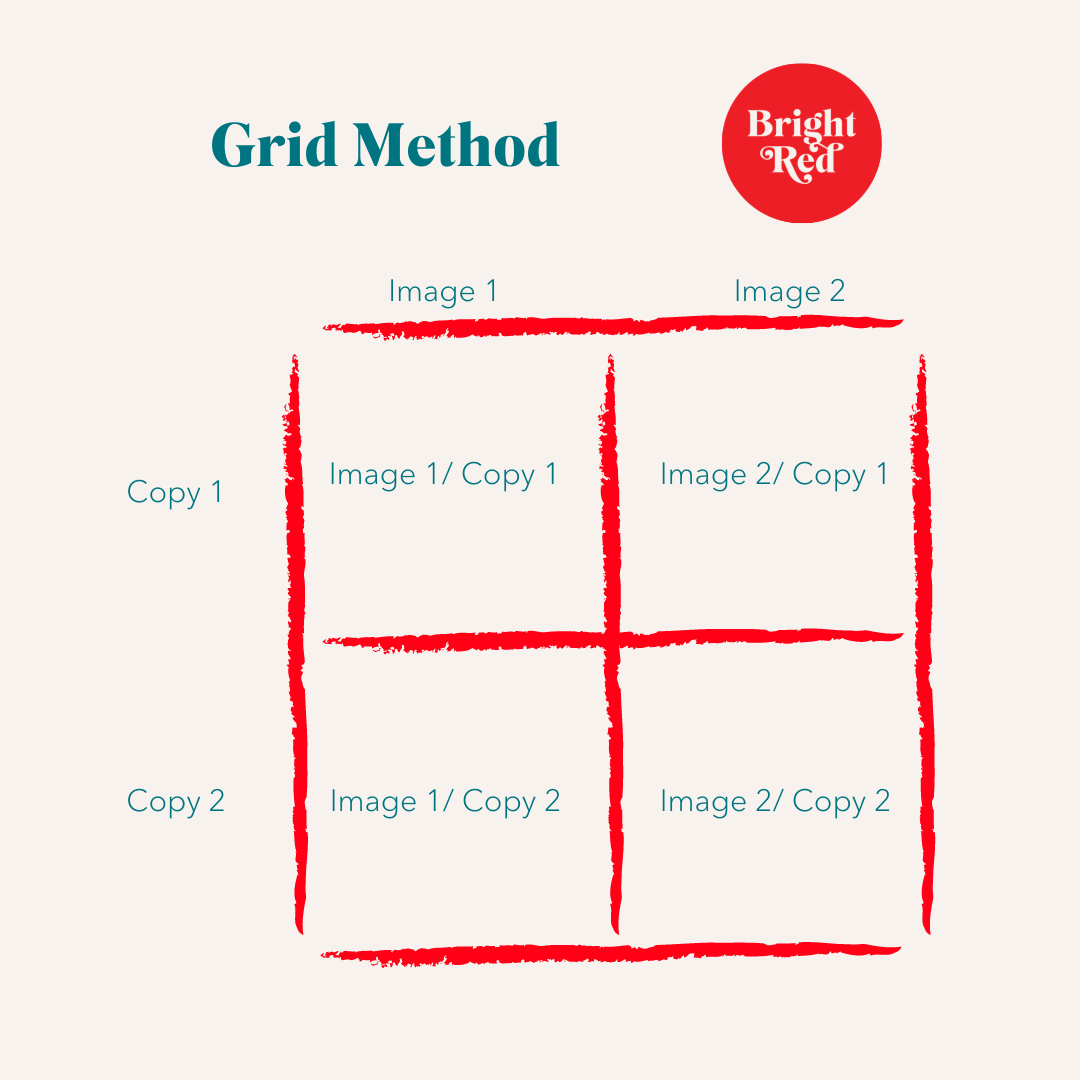If you want to succeed in the ever changing world of Facebook ads. You. Must. Test. Everything.
But what does that even look like when you are running a business and have 7 other hats on at all times?
I’m going to show you a couple of really simple processes to ensure you’re always testing, and you have a plan around what you’re testing and why. Without having to have a “plan” because no one has time to really plan each and every ad.
I recommend using the Grid Method, combined with one of the other methods as a bare minimum – but if all you can do at the moment is the grid method – start with that.
Grid Method:

The Grid Method as you can see, is based on a – you guessed it – grid. You don’t have to draw up the grid every time, but it’s a nice visual to keep in mind.
In essence you’ll create two pieces of imagery – static image, GIF or video, and two pieces of copy. You’ll then mix and match them as you can see in the grid above.
You’ll then run these ads. What this does is help you to identify which style of imagery or copy is working best. If copy 1 is short and copy 2 is long. The difference in results will give you an idea of whether your customers like short or long form copy.
The best bet here is to keep the difference minor. So if you’re testing long vs. short copy – the start of the copy should be almost identical. The grid methods success comes from testing small minor changes so you can see which performs best.
Once you have some good results. You’ll repeat this process with Image 3 and Copy 3 – and keep repeating. Essentially it’s battle of the copy and images and you’ll constantly find a new winner. It’s a great way to make sure you’re always improving your ads rather than just flying blind all the time.
Hypothesis Method:
This is another of my favourites – so say you’ve been running the grid method for a while and you’ve got a decent budget under your belt – at least $30 per ad set. You can afford to add some new ads into the mix. This is when I like the hypothesis method.
So say Image 3/Copy 1 is the best performer. You may look at this ad and come up with a theory – it might be something like, I think this works because it is really bright and colourful, or it addresses this particular pain point well, or the model is attention grabbing.
You then take that theory and come up with 2-3 variations that would prove your point. So you might find 3 more photos with that model, or a similar model, you might try different ways of wording that particular pain point, or find more bright and colourful imagery to use. And then test those.
The difference between this and the grid method, is with the grid method you are making very small changes – the hypothesis method gives you some freedom to try some more out there concepts based on why you think a particular ad is working.
Copy Cat Method:
The copy cat method is great when you get stuck for inspiration or when the results you’re getting just aren’t getting the results you need and you need bigger jumps than what you’re getting with the smaller changes testing strategies.
Essentially what you’re going to do is head to the Facebook Ads Library and search some of your competitors and brands you love.
Now, you are NOT going to copy what you see – even though this is the copy cat method – what you are going to do is be inspired by what others are doing. Is the way they right copy different, are the way they are presenting their images different, how can you apply these difference to your brand. Do not copy. For starters, it’s dodgy business practises, secondly, you have no idea if those ads are even working. But you can get inspiration to try something new.
Persona Method:
The persona method is more used for testing new audiences. So I hate ‘personas’ as a general rule, but so many people use them, so I don’t rule them out completely.
For the persona method what you’re going to do is work out 4-5 different people that buy from you – what makes them unique from each other? One might be reading Vogue on weekends and shopping at op shops. Another may be looking for the best deal and loves to follow fashion influencers. Another might like small boutiques. Each of these personas will have dozens if not hundreds of varied interests. What you then do is create audiences based on these categories.
It’ll then allow you to test a number of different audiences to reach your people and get that cost per purchase down.
Weird Tangent Method:
And last but least the weird tangent method – this is my favourite, but that’s because my brain is weird. So this is exactly like the hypothesis method – except instead of a theory based on what’s currently working. You test something totally random.
You might be running bright colourful ads because that’s on brand, but you want to see what black and white does, just because. It might be that you’re always using friendly – non-salesy copy – what happens if you try a full on sales copy method. What if you try a new style of video? The weirder and more obscure from what you usually do the better.
I find sometimes brands get so stuck in their ‘branding’ that they let their ads get boring and stale because they never try anything new. There is no permanent record of your Facebook ads, it’s not permanently on your Instagram feed – feel free to have a little fun with your ads every now and then.
What next?
Need a hand with your testing or what to know if you’re doing it right? Or perhaps you want someone to take over so you can take one of those hats off?
Book in one of our free strategy sessions and we can help!




